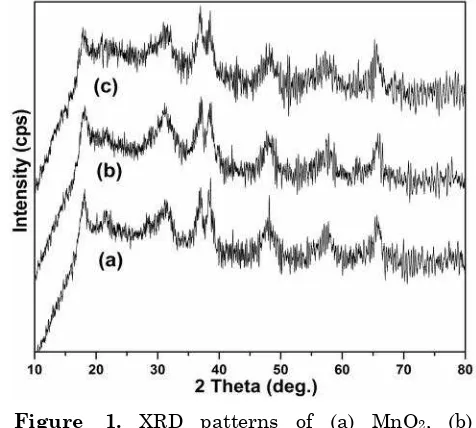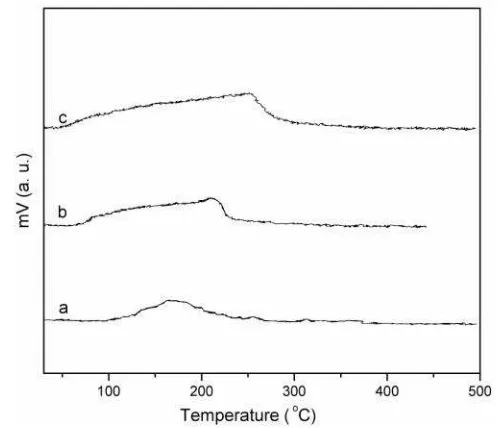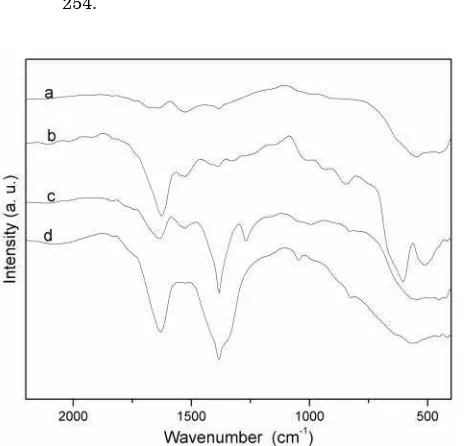Preparation, Characterization and NO-CO Redox
Reaction Studies over Palladium and Rhodium Oxides
Supported on Manganese Dioxide
M.S. Fal Desai, R.K. Kunkalekar, A.V. Salker*
Department of Chemistry, Goa University, Goa 403206, India
* Corresponding author.
E-mail: [email protected], [email protected] (Salker, AV.)
Tel.: +91-832-6519315, Fax: +91-832-2452889
Bulletin of Chemical Reaction Engineering & Catalysis, 10 (1), 2015, 98-103
Received: 22nd November 2014; Revised: 31st January 2015; Accepted: 2nd January 2015
Abstract
The catalytic activity of PdO/MnO2 and Rh2O3/MnO2 is investigated for NO-CO redox reaction. Supported
catalysts are prepared by wet impregnation method. Among the tested catalysts, PdO/MnO2 shows higher
activity for this reaction. Active metal dispersion on MnO2 enhances the selectivity for N2 over N2O in this
reaction. The XRD substantiate the formation of MnO2 monophasic phase. SEM images show the formation
of elongated particles. TEM images indicate nano-size rod-like morphologies. An increase in the catalytic activity is observed on supported Pd and Rh oxides on MnO2. Temperature programmed desorption studies with NO and CO are undertaken to investigate the catalytic surface studies. © 2015 BCREC UNDIP. All rights reserved
Keywords: Nitric oxide; Carbon monoxide; MnO2; PdO; Rh2O3
How to Cite: Fal Desai, M.S., Kunkalekar, R.K., Salker, A.V. (2015). Preparation, Characterization and NO-CO Redox Reaction Studies over Palladium and Rhodium Oxides Supported on Manganese Di-oxide. Bulletin of Chemical Reaction Engineering & Catalysis, 10 (1): 98-103.
(doi:10.9767/bcrec.10.1.7802.98-103)
Permalink/DOI: http://dx.doi.org/10.9767/bcrec.10.1.7802.98-103
Available online at BCREC Website: http://bcrec.undip.ac.id
Research Article
1. Introduction
Oxides of nitrogen (NOx) and carbon monox-ide (CO) are unambiguously serious air pollut-ants and harmful to living beings. NOx is a ma-jor cause of acid rain and photochemical smog. Both NO and CO are mostly produced as ex-haust gases from motor vehicles and industries. Several methods have been developed for the NO and CO removal to meet the increasingly stringent regulations imposed on exhaust emis-sions. Fortunately, catalytic method for the re-dox reaction is available and is considered to be a powerful technique in detoxification of these gases. The efforts of the researchers are di-rected towards the development of various new
catalytic methods to control the emission of these pollutants in the environment [1-4]. Se-lective catalytic reduction (SCR) of NOx is one of the most efficient and economical technology for the removal of NOx by using reducing agents such as NH3, hydrocarbons, CO and H2 [1-8]. CO as a reducing gas offers some distinct advantages of being emitted from the same ex-haust of vehicles due to the incomplete combus-tion of fossil fuels. Lot of research has been fo-cussed on developing catalysts for the reduction of NO by CO which will promote the simultane-ous detoxification of these two pollutants [7-12]. Most of the reported catalysts tested for NO-CO reaction give complete NO conversion at much higher temperatures and hence it is necessary to develop a catalyst which can give complete NO-CO conversion to nitrogen and CO2 at comparatively lower temperatures.
materials because of its valuable technological applications in catalysis, electrochemistry, mo-lecular adsorption, waste removal, ion ex-change processes and magnetic applications [7, 8, 12-15]. It has superior ability to activate and supply oxygen which is helpful in catalytic re-dox reactions. Nano-sized MnO2 is expected to exhibit good performance because of its large surface area and good activity. The properties of MnO2 are influenced significantly by its structure, morphology and preparative meth-ods. Different types of manganese oxides, doped manganese oxides, mixed manganese oxides, metal supported manganese oxides are widely used for NO reduction and CO oxidation reac-tions [3-8, 13-16]. MnO2 exhibits considerable enhance activity when incorporated with some active metals or metal oxides. There are scanty reports of precious metals or metal oxides sup-ported on MnO2 catalysts for lower tempera-ture NO-CO reaction.
The present investigation reports the prepa-ration of palladium and rhodium oxides sup-ported on manganese dioxide by wet impregna-tion method. The catalysts are characterized by different instrumental techniques and tested for NO - CO redox reactions. Active metal sub-stitution enhances the activity and selectivity for N2 in NO-CO reaction. Chemisorption of CO and NO was studied over these catalysts.
2. Experimental
2.1. Catalysts Preparation
PdO/MnO2 with 5.9 wt% Pd loading and Rh2O3/MnO2 with 5.7 wt% Rh loading catalysts were prepared by wet impregnation method. The nano-sized pristine MnO2 powder was pre-pared by dextrose assisted co-precipitation method. Mn(CH3COO)2.4H2O (Sigma-aldrich 99.9%) was dissolved in distilled water and 2% of dextrose solution was added at 100 oC. Pre-cipitation was carried out by dropwise addition of 10% NaOH solution under vigorous stirring. This suspension of manganese hydroxide (pH=9) was subjected to oxidation using 30% H2O2. The precipitate was then filtered, washed and dried at 120 oC for 10 h. MnO2 was mixed with an aqueous solution of appropriate amount of metal ions (PdCl2 and RhCl3 from Sigma Aldrich, 99.9 and 99.98% respectively) under vigorous stirring. Sodium hydroxide (10%) solution was added drop wise with the constant stirring to precipitate supported met-als as metal hydroxide. Solution was allowed to stand and then checked for the complete pre-cipitation by adding more NaOH. The precipi-tate was filtered, washed with distilled water
and dried in air. The obtained samples were ho-mogenized well in mortar and pestle and dried at 250 oC for 5 h.
2.2. Catalysts Characterization
X-ray powder diffraction measurement was carried out on a RIGAKU diffractometer, using Cu Kα radiation (λ = 1.5418 Å, filtered through Ni filter) to investigate the structure as well as phase of the prepared catalysts. The surface morphology was determined with JSM-5800LV Scanning Electron Microscope (SEM). The Transmission electron microscope (TEM) im-ages were recorded using PHILIPS CM 200 electron microscope with a resolution of 2.4 Å. The BET surface area was measured by nitro-gen adsorption at liquid Nitronitro-gen temperature using SMART SORB-91 surface area analyzer. NO and CO TPD studies of the samples were carried out using Quantachrome Autosorb iQ. For TPD studies 5% of gas (CO or NO) in N2 was passed over 0.2 g of catalyst at 100 oC for 30 mins, then cooled and flushed with N2 and sample was subjected to TPD analysis using TCD detector. FTIR spectra of NO adsorbed samples were recorded at room temperature using Shimadzu IR Prestige 21 spectrometer.
2.3. Catalytic Activity Tests
The catalytic tests for NO reduction by CO were performed in a continuous flow, fixed bed glass reactor. The catalyst powder weighing 0.9 g was supported between glass wool plugs in a glass reactor which was placed in an electric furnace. Catalytic activity was determined us-ing a feed gas composition of 5% NO and 5% CO in 90% argon and passed over the catalyst at a rate of 5000 ml h-1. The catalysts were heated in N2 atmosphere at 100 oC for 20 min prior to the reaction. The feed gases and the products were analyzed employing an online Gas Chromatograph with molecular sieve 13X and Porapak Q columns with H2 as a carrier gas.
3. Results and Discussion
3.1. Catalysts Characterization
widths are observed, indicating the poor crys-tallinity and nano size of these catalysts. Since Pd and Rh oxides are highly dispersed over MnO2 support in low concentration, no extra reflections are observed in the XRD pattern.
The topography and morphological features of the samples are investigated by SEM. Figure 2 shows the SEM images of (a) PdO/MnO2 and (b) Rh2O3/MnO2 catalysts. The SEM images show the aggregates of fine particles. The ag-gregates have moderately elongated rod-like morphology. The representative TEM images are given for pristine MnO2 and Rh2O3/MnO2 catalysts (Figures 2c and 2d). From Figure 2c, it can be seen that MnO2 catalyst shows
rod-like nano particles with thickness less than 10 nm. Similar features are shown by Rh2O3/MnO2 catalyst (Figure 2d). Inset in both the TEM im-ages illustrate electron diffraction patterns. The electron diffraction patterns show clear concentric ring patterns indicating polycrystal-line nature of the samples. These results are further supported by noisy X-ray diffraction pattern indicating nano-crystalline nature of these samples.
The BET surface area of all the catalysts is determined using nitrogen adsorption at boil-ing liquid nitrogen temperature. The BET sur-face areas of MnO2, PdO/MnO2 and Rh2O3/MnO2 are found to be 62, 65 and 60 m2g-1 respectively. Current preparation procedure was successful in getting uniform and high sur-face area catalysts.
3.2. NO Reduction by CO
Catalytic NO reduction by CO over different catalysts as a function of temperature is pre-sented in Figure 3. The results show that the products of NO reduction by CO for all samples are N2 and CO2. N2O formation is observed at lower temperature (Figure 4). From the figure it is clear that the supported catalysts show much higher activity than pristine MnO2. PdO/MnO2 shows higher activity than Rh2O3/MnO2 catalyst. Catalysts such as Pd/Al2O3, Rh/Al2O3 and Rh/AlPO4 reported in literature exhibit lower activity for NO reduc-tion by CO, exhibiting conversion at higher temperatures [17-18]. The light-off tempera-ture (T50 i.e. 50% conversion) of MnO2 is ob-served at 318 oC. PdO/MnO2 shows T50 at 160 Bulletin of Chemical Reaction Engineering & Catalysis, 10 (1), 2015, 100
Figure 2. SEM images of (a) PdO/MnO2, (b) Rh2O3/MnO2 and TEM images of (c) MnO2, (d) Rh2O3/MnO2
Figure 3. NO conversion in NO reduction with CO over all samples (5% NO, 5% CO in argon at 5000 ml h-1).
oC while that for Rh2O3/MnO2 is observed at 190 oC. Thus, introduction of small amount of PdO and Rh2O3 over MnO2 greatly improves the catalytic activity of NO conversion and drastic decrease in temperature is observed for total conversion. It is a well-established fact that at low temperature surface is predomi-nantly covered with CO and increase in tem-perature will favor reduction of active catalytic sites by desorption of CO2 with lattice oxygen participation. Reduced catalytic surface is prone for NO adsorption which will get reoxi-dised by dissociative desorption of NO. Pd and Rh are well known for NO reduction by CO over inert support like Al2O3 [17, 18]. Syner-getic effect of these highly active metals on ac-tive support as MnO2 enhances their catalytic activity.
CO conversion occurs in-line with NO con-version. The higher activity is shown by PdO/MnO2, indicating that the presence of PdO fastens the catalytic reaction of NO reduction by CO. The activity for redox reactions were re-peated three times with PdO/MnO2 catalyst and the results were found to be satisfactory with no considerable decrease in the activity.
3.4. Temperature Program Desorption of CO and NO
CO desorption profiles are depicted in Fig-ure 5. All catalysts show a typical single broad CO desorption peak. In MnO2, maxima for CO desorption at 173 oC is observed, which is com-paratively at a lower temperature as compared to the Rh (210 oC) and Pd (254 oC) supported catalysts. Quantum of CO chemisorbed over PdO/MnO2 and Rh2O3/MnO2is also found to be
Bulletin of Chemical Reaction Engineering & Catalysis, 10 (1), 2015, 101
higher than that of pristine MnO2 which indi-cates there is increase in number of active sites for CO adsorption that is needed for the reduc-tive CO2 desorption from the oxide surface.
Desorption of NO over the catalyst is rather found complex in nature as observed from the Figure 6. MnO2 shows two distinct desorption peaks with peak maxima at 200 and 340 oC re-spectively. Former signifies a weak adsorption while the later suggests a strong adsorption. In case of supported catalysts, three distinct desorption maxima are observed. These peaks at higher temperature are due to stronger ad-sorption, indicative of more than one binding mode of NO with the catalyst. Since it is diffi-cult to comment on the binding modes of NO solely based on TPD profile, FTIR spectrum of chemisorbed NO is recorded for all the cata-lysts along with the pristine MnO2 with and without NO adsorption. Pristine MnO2 show no prominent absorption in the region 1640 - 1250 cm-1 as observed from the Figure 7. IR spectra shows characteristic v(MN-O) vibration in the range 1640 - 1250 cm-1 for the NO treated cata-lysts signifying NO adsorption [19]. For pris-tine MnO2, NO chemisorption shows only one major peak at 1627 cm-1, which is assigned to the terminal v(MN-O). Apart from this, intensi-ties of other peaks in the range 1550-1250 cm-1 are found to be very weak, indicating only one major mode of adsorption. Bands at around 1630 cm-1 can be attributed to the M-NO– spe-cies [20]. IR data of the Rh supported catalysts shows peaks at 1381 and 1334 cm-1 [v(ONO)]. Whereas peaks at 1381 and 1265 cm-1 [v(ONO)]
Figure 4. N2O (solid line) selectivity and N2 selectivity (dotted line) over all samples (5% CO, 5% NO in argon at 5000 ml h-1).
Bulletin of Chemical Reaction Engineering & Catalysis, 10 (1), 2015, 102
are observed for Pd [21]. Rh and Pd are elec-tron rich transition elements compared to Mn. They are expected to lower the NO bond order by forming M-NO–,that can in turn facilitate the dissociative desorption of NO, thus increas-ing the activity.
4. Conclusion
The supported catalysts PdO/MnO2 and Rh2O3/MnO2 were prepared by wet impregna-tion method. The TEM and SEM images con-firmed the nano-size formation of these cata-lysts along with elongated rod-like morpholo-gies. Catalytic NO reduction by CO was per-formed on all the prepared catalysts. CO con-version was obtained in-line with NO conver-sion. The supported catalysts showed higher activity than pristine MnO2. PdO/MnO2 gave higher activity than Rh2O3/MnO2 for the cata-lytic reaction studied. Selectivity for N2 over N2O was also enhanced after dispersion of Pd and Rh on MnO2 in NO reduction reaction. Since the surface area of catalysts is uniform, enhancement in activity is attributed to an in-crease in active sites for the catalytic reaction. CO TPD confirmed an increased quantum of CO adsorption on supporting Pd and Rh. NO desorption profile over the supported catalysts showed multiple desorption peaks suggesting different modes of strong and weak adsorption. NO desorption studies were found to be in com-pliance with the FTIR, suggests multiple bind-ing modes of NO and insights the formation of M-NO- species. In supported catalysts,
forma-tion of M-NO– species considerably lowered bond order of N-O which boosts the oxidative dissociative desorption of N2.
Acknowledgements
Authors are grateful to University Grant Commission, New Delhi, for the financial sup-port.
References
[1] Thirupathi, B., Smirniotis, P.G. (2012). Nickel-doped Mn/TiO2 as an efficient catalyst
for the low-temperature SCR of NO with NH3:
catalytic evaluation and characterizations.
Journal of Catalysis, 288: 74-83.
[2] Salker, A.V., Naik, S.J. (2009). Mechanistic study of acidic and basic sites for CO oxida-tion over nano based Co2−xFexWO6 catalysts.
Applied Catalysis B: Environmental, 89:
246-254.
Figure 6. Temperature program desorption of NO over (a) MnO2, (b) Rh2O3/MnO2 and (c) PdO/MnO2.
Figure 7. FTIR spectra of chemisorbed NO over (a) pristine MnO2 without NO adsorption and (b) MnO2 (c) Rh2O3/MnO2 and (d) PdO/MnO2 on NO adsorption
Bulletin of Chemical Reaction Engineering & Catalysis, 10 (1), 2015, 103
[3] Shan, J., Zhu, Y., Zhang, S., Zhu, T., Rouvi-mov, S., Tao, F. (2013). Catalytic Performance and In-situ Surface Chemistry of Pure ǂ -MnO2Nanorods in Selective Reduction of NO and N2O with CO. Journal of Physical.
Chem-istry C, 117: 8329-8335.
[4] Granger, P., Parvulescu, V.I. (2011). Catalytic NOx Abatement Systems for Mobile Sources: From Three-Way to Lean Burn after-Treatment Technologies. Chemical Revision, 111: 3155-3207.
[5] Li, J., Chen, J., Ke, R., Luo, C., Hao, J. (2007). Effects of precursors on the surface Mn spe-cies and the activities for NO reduction over MnOx/TiO2 catalysts. Catalysis Communica-tion, 8: 1896-1900.
[6] Stankova, N.B., Khristova, M.S., Mehandjiev, D.R. (2001) Catalytic reduction of NO with CO on active carbon-supported copper, man-ganese, and copper-manganese oxides.
Jour-nal of Colloid Interface Science, 241: 439-447.
[7] Wan, H., Li, D., Dai, Y., Hu, Y., Liu, B., Dong, L. (2010). Catalytic behaviors of CuO sup-ported on Mn2O3 modified DŽ-Al2O3 for NO reduction by CO. Journal of Molecular
Ca-talysis A: Chemical, 332: 32-44.
[8] Patel, A., Shukla, P., Chen, J., Rufford, T.E., (2013). Acyclic reaction pathway triggered by ammonia for the selective catalytic reduction of NOx by ethanol over Ag/Al2O3. Applied
Ca-talysis B: Environmental, 136: 103-111.
[10] Lv, Y., Liu, L., Zhang, H., Yao, X., Gao, F., Yao, K., Dong, L., Chen, Y. (2013). Investiga-tion of surface synergetic oxygen vacancy in CuO–CoO binary metal oxides supported on DŽ-Al2O3 for NO removal by CO. Journal of
Colloid Interface Science, 390: 158-169.
[11] Yao, X., Tang, C., Ji, Z., Dai, Y., Cao, Y., Gao, F., Dong, L., Chen, Y. (2013). Investigation of the physicochemical properties and catalytic activities of Ce0.67M0.33O2 (M = Zr4+, Ti4+, Sn4+)
solid solutions for NO removal by CO.
Cataly-sis Science and Technology, 3: 688-698.
[12] Xue, X. Y., Xing, L. L., Wang Y.G., Wang, T.H. (2009). Preparation, characterization and electrical transport properties of individ-ual ǂ-MnO2 and ǃ-MnO2 nanorods. Solid State
Science, 11: 2106-2100.
[13] Kunkalekar, R. K., Salker, A.V. (2013). Activ-ity of Pd doped and supported Mn2O3
nano-materials for CO oxidation. Reaction Kinetics
Mechnism and Catalysis, 108: 173-182.
[14] Kunkalekar, R. K., Salker, A.V. (2010). Low temperature carbon monoxide oxidation over nanosized silver doped manganese dioxide catalysts. Catalysis Communication, 12: 193-196.
[15] Njagia, E. C., Chen C. H., Genuino, H., Galindo, H., Huang, H., Suib, S. L. (2010). Total oxidation of CO at ambient temperature using copper manganese oxide catalysts pre-pared by a redox method. Applied Catalysis B:
Environmental, 99: 103-110.
[16] Salker, A.V., Kunkalekar, R. K., (2009). Palla-dium doped manganese dioxide catalysts for low temperature carbon monoxide oxidation.
Catalysis Communication, 10: 1776-1780.
support interaction and thermal aging.
Jour-nal of Colloid Interface Science, 408: 157-163
[19] Nakamoto, K. (2009). Infrared and Raman spectra of inorganic and coordination com-pounds, Part A, 6th edition. Wiley, United State.
[20] Long R.Q., Yang R.T. (1999). In Situ FT-IR
Study of Rh−Al−MCM-41 Catalyst for the
Se-lective Catalytic Reduction of Nitric Oxide with Propylene in the Presence of Excess Oxy-gen, Journal Physical Chemistry B, 103: 2232-2238.
[21] Worz A. S., Judai K., Abbet S., Heiz U.J. (2003). Cluster Size-Dependent Mechanisms of the CO + NO Reaction on Small Pdn (n ≤
30) Clusters on Oxide Surfaces, Journal of


